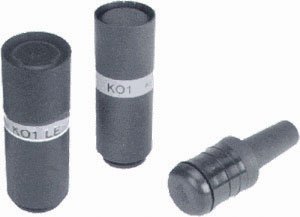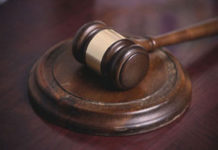GILROY
– Large rubber bullets in the Gilroy Police Department’s arsenal
were put to use for the first time recently – with success.
In a Jan. 30 stand-off with a man brandishing a metal rod, city
police successfully debuted a gun that shoots large rubber bullets
designed to take down aggressors alive and without major
injury.
GILROY – Large rubber bullets in the Gilroy Police Department’s arsenal were put to use for the first time recently – with success.
In a Jan. 30 stand-off with a man brandishing a metal rod, city police successfully debuted a gun that shoots large rubber bullets designed to take down aggressors alive and without major injury.
It did its job successfully, police said. Someone could have been killed or seriously injured, but no one was. Sgt. Noel Provost, who was there, described police’s handling of the situation as “textbook.”
The rubber “baton rounds,” 1.5 inches in diameter and three inches in length, are so named because a blow from one is considered to have an impact roughly equal to that of a police baton. For another analogy, “It’s comparable to being hit by a major league fastball directly in the chest,” police Sgt. Kurt Ashley said. “It’s going to hurt, but it shouldn’t break anything or cause any permanent damage.”
The baton rounds have been in GPD’s arsenal for about a year. They fall under the category of “less lethal force,” a verbiage that acknowledges two things: that they are a far safer alternative to standard bullets, but that people have died from rubber ammunition in the past.
Rubber bullets and their many relatives have been controversial worldwide since people were killed and blinded by them in Northern Ireland in the early 1970s. Such projectiles have since been upgraded to be less deadly and more accurate, but debate over them still flares up. In May 2002, researchers condemned the use of rubber-coated metal bullets for crowd and riot control by the Israeli military. That study, printed in The Lancet medical journal, said Israeli forces often caused severe injuries by shooting from too-close range or too inaccurately; yet even proper use of the weapons caused some unintended injuries.
Nevertheless, shooting rubber bullets into crowds of political protesters, as in Israel, is more likely to generate controversy than shooting them at a single, armed aggressor, as Gilroy police did on Jan. 30.
After an officer stopped 31-year-old Angel Aguero for a traffic violation, Aguero took a metal bar about two feet long out of his car and advanced on the officer threateningly, according to police. The officer radioed for back-up, but when it arrived, the man said they would have to kill him before he’d drop his weapon.
Gilroy police protocol allows officers to fire their pistols in defense of their lives or the lives of others. Such force was “clearly” justified in this case, according to Assistant Chief Lanny Brown. One blow to the head with the bar could have killed someone, Provost said, so police didn’t dare get within swinging range.
Instead of firing a pistol, however, an officer knocked Aguero backward with two rubber bullets, prompting him to drop the bar. Officers then moved in, pepper-sprayed Aguero and tackled him. He still resisted, Provost said, but police took him into custody without injury to themselves and with no major injury to Aguero.
Aguero undoubtedly experienced pain when the rubber bullets hit the front of his body, and police had him checked out at Saint Louise Regional Hospital afterward. He was found to have no broken ribs or internal injuries, Ashley said, and police took him on to county jail. Saint Louise officials, who are prohibited by law from sharing detailed patient information, said only that Aguero was “treated and released” that day.
All sworn GPD officers are trained in rubber baton rounds’ use and procedures, but patrol officers don’t carry them. They’re only stored in supervisors’ cars. According to Ashley, a supervisor would respond to any situation in which such a tool is needed.
The unidentified Gilroy police officer who fired the rubber bullets at Aguero did not get temporary time off work for an investigation, as he would have if he had fired his traditional side arm.
For about five years, the GPD has also had 12-gauge shotguns that shoot “sock rounds,” cloth pouches similar to beanbags, filled with lead pellets. Only the Special Operations Group – the GPD’s SWAT equivalent – is authorized to use these, Brown said. He thinks the department has only used them “once, maybe twice.”
“I don’t think we’ve used that for probably three years,” Brown said.
Santa Clara County sheriff’s supervisors also carry guns loaded with rubber baton rounds, according to Lt. Larry Lopez, who supervises the sheriff’s South County headquarters.
The California Highway Patrol has 37 mm baton rounds made of hard foam as well as “stinger rounds,” clumps of small rubber balls that spray like bird shot. Officers are supposed to bounce the stinger rounds off the ground at their targets, said CHP Officer Terry Mayes, spokesperson for the Gilroy-Hollister CHP region. These weapons are intended for riot control only, Mayes said.
In September 2001, Los Angeles police used rubber bullets on rioters upset by the cancellation of a free concert by heavy metal band System of a Down. Crowd members were treated for minor injuries, the BBC reported.
The British first developed baton rounds made of teak wood to control rioters in Hong Kong in 1967. They then developed baton rounds made of hard rubber – for which they coined the term “rubber bullets” – for use on rioters in Northern Ireland in the early 1970s. Police were supposed to bounce the bullets off the ground and into the targets’ legs. Controversy ensued when people died from them, and they were replaced by plastic bullets, made of PVC.
Plastic bullets in use today are said to be less dangerous and more accurate than their rubber predecessors, but British Home Secretary Jack Straw warned in 1999 that “Misuse could lead to serious injury or worse,” according to the BBC.
Variations of rubber bullets are used in many countries, including the United States, according to The Associated Press. These include rubber-coated metal bullets, rubber plugs, plastic baton rounds, sock rounds and beanbag rounds – older, less accurate versions of sock rounds.














